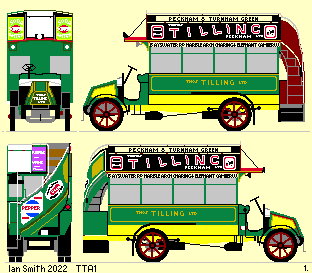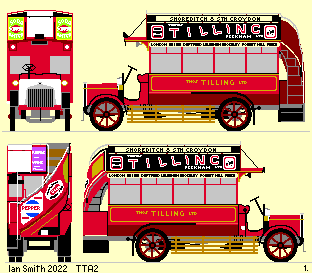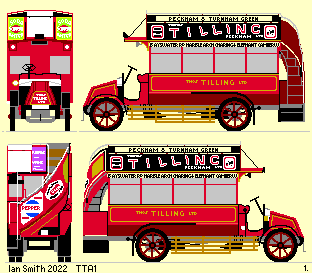
The Tilling London TTA1
This page prepared by Ian Smith, created 12th February 2022.
|
Pre-ambleThomas Tilling Ltd was a well-established bus operator in south-east London, centred on a number of yards and factories in the Lewisham and Peckham area. At the turn of the century it was a horse-bus operator, with 220 horse-buses. But the need for motor buses was already manifesting itself, and in September 1904 Tilling introduced the first normal double-decker motor bus, a Milnes-Daimler with 34-seater body (18 seats in nine pairs on top, and sixteen on longitudinal benches inside). That was put into service on "The Times" route between Peckham and Oxford Circus, displacing two horse buses. A success, it was soon followed by fifteen more Milnes-Daimler buses, displacing another twenty horse buses.Other types of motor-buses were tried: a Bussing and a Dennis. Another route, Peckham - Lewisham, was added in 1906, quickly extended to Catford, plus a Catford to Greenwich Pier service. More motorbuses were added, more Milnes-Daimlers and Tylor-engined Dennises. An Oxford Street-Sidcup service was started, a longer route facilitated by motor buses. "Queenie"Reliability of the motor buses was not wonderful, and ex-horsebus drivers had problems adjusting to buses with gears. So in 1908 Tilling introduced a petrol-electric bus. A petrol engine drove a dynamo, which fed two electric motors - one for each rear wheel. This was the SB&S bus, called after its originators: Smith, Brown & Stevens. The driers named it Queenie, as it was so nice to drive and work with. It went into service on the Peckham - Oxford Street service."TTA1"
The SB&S bus was followed by the first TTA1 in June 1911. This was a petrol-electric with a more powerful 30hp engine, to overcome the slow acceleration experienced with Queenie. It had a standard 34-seater body - a direct descendant of the horse-bus bodies - and a distinctive Renault-style bonnect. This was a success, and Tillings decided to make it their standard. They were allowed by their agreement with the LGOC to operate 150 motor buses, and over the next two years TTA1s were built to bring their fleet up to the London limit. Livery, which had been dark green with gold lining and yellow chassis for the Times buses became a standard red with brown chassis. Early TTA1s were built at Bull Yard, with bodies from the Wren Road works in Camberwell, but Tillings took control of W.A.Stevens Ltd in 1912, so production was switched to the Tilling-Stevens works in Maidstone. TTA1s were also built for other operators, such as Midland Red. Later buses acquired the dog-rails, and photos indicate that the sidelights - carried high under the canopy and presumably electric - were supplemented by one or two large headlights mounted alongsise the petrol tank, ahead of the cab bulkhead. Presumably this was because later routes took the buses beyond the central area's street lights, when they ventured out to Bromley Common, Farnborough, Coulsdon and Reigate.
The increasing number of TTA1s operated jointly with the General on a number of routes, alongside their B-types. The numbers on each of the shared routes varied fairly frequently. Tilling needed new garages to accommodate their fleet. Bull Yard, used at first for the Peckham-Oxford Circus route, was turned over to manufactures and maintenance, and the buses moved to a new garage at Arch Street, near the Elephant & Castle. Lewisham was another TTA1 garage. Victory Place was opened in May 1912, up near the New Kent Road, to replace Arch Street. The joint workings with General increased. The Sidcup - Lewisham route was extended to Victoria, and worked jointly as the 39. Tillings route 36 (West Kilburn-Victoria) was extended in June 1912 to joint operation to Catford, alongside General B-types. On Sundays Tilling worked south to Bromley (route 64). Sunday operations to Sidcup were the 63.
The Bromley-Lewisham route was converted to TTA1s from horses in July 1912 and extended to Shoreditch as the 47. This route prospered. In March 1913 it was extended to Farnborough. Now this long route used 26 TTA1s. In 1913 the horses had been replaced on the Blackheath - Penge service, the new 75 route using 12 TTA1s at first, from Woolwich Free Ferry to South Croydon. Horses also went from the Dulwich - Liverpool Street route, replaced by motors on the 78 (Dulwich - Shoreditch) In June 1913 the rising number of TTA1s required another garage. This was at Acorn Street, near Camberwell. This gave Tilling working motor bus garages at Lewisham, Victory Place and Acorn Street. At this time another horse route was converted, that between Forest Hill and Penge. This was replaced by the 55, from Shoreditch to South Croydon. Tilling ventured into new territory with route 10, worked jointly with LGOC, from Elephant & Castle to Wanstead. The last TTA1s arrived in November 1913. It would be some time before larger replacements arrived, in the shape of TT3As. Tilling now had its full allowance on 150 buses for weekday use, in accordance with their somewhat punitive agreement with the General. The last eight went into service on the 35A (Camberwell Green - Walthamstow). Following the General's reaching a working agreement with the National Steam Car company route 12 was revised to operation by all three companies, Tilling running ten TTA1s on the Turnham Green - Nunhead section. Tillings took the six buses off the 36 and put them onto the 35A. In March 1914 the ten Tilling buses on route 10 were moved onto new route 10A (Elephant & Castle - Buckhurst Hill). At the same time route 60 was diverted to South Tottenham. In April Tilling withdrew from the 12, leaving it to National. Tilling started new route 63 (Oxford Circus - Peckham - Brockley Station) using its 10 from the 12, plus 8 from the 47 (rep laced by General working from Dalston), plus two from the 35A and four from the 60. Tillings' short 92 was replaced in June, its four buses being added to the 75 allocation. Route 60 was withdrawn in late June 1914, the Tilling buses from it going onto the 42 (Finsbury Park Stn - Camberwell Green) and the 43A (Muswell Hill (Sat/Sun) - Highgate - Peckham Rye).
The Great WarThe agreement between Tilling and the LGOC provided for the latter to provide garages for the Tilling operations. But the First World War delayed things somewhat. The General's own Catford garage (AN), intended for transfer to Tilling, was requisitioned by the War Department in 1915, as was General's Camberwell garage.The TTA1s soldiered on during the Great War - not literally as was the case for many of General's B-types. But the loss of General B-types meant that the sharing arrangements needed altering, as did the calls on manpower from the services, first through volunteering and then through conscription. Some routes were abandoned, some reduced in frequency, some shifted to a greater Tilling contribution. Route 43A was greatly reduced to bolster the 42. The 47 and 78 fully returned to Tilling. The 10A gave way to a 10B for a while, until withdrawn. The 35A gained a greater Tilling share, actually increasing the weekday maximum to 152. The 39 to Sidcup was replaced by an increased route 21, which also redulted in the disappearance of the 92. The loss of LGOC Catford garage require Tilling to make a larger contribution to the 21, 36 and 47, which required Tilling to give up the 10A and 40. Tilling explored ways to escape from the lop-sided relationship with the General, and started operations in Brighton, where it sent five TTA1s. On the other hand, General started to make good on its promise to provide garage premises with a new garage in South Croydon. This took in the 40 buses from Victory Place (which closed for bus use), four from Acorn Street and forty from Lewisham. This required some rearrangementof allocations Route 21 was extended at the south-eastern end, some journeys continuing beyond Sidcup to Foots Cray to serve munitions factories, but was cut back at the other end from Crouch End to Wood Green. But new routes were needed too, in particular to serve the Royal Ordnance Depot at Woolwich - the Woolwich Arsenal. The 75 was boosted, and extended to Plumstead, and the 75A was added. The shift working at the factories required heavily peaked working, for which Tilling was subsidised. A new 93 was operated by Tilling from Woolwich to Sidcup. In 1917 the Acorn Street garage was closed, and Tilling transferred twenty buses to Brighton. There were substantial changes to Tillings' work on the 21 and 47. Tillings London operations had been shifted southwards, with just Lewisham and South Croydon garages. Route 59 was taken over from the LGOC (MET), which had operated it from Streatham. Now Croydon worked it from Camden Town (Sundays) or Oxford Circus to South Croydon (59) or Caterham (59A) or Reigate (59B). These suffered restrictions due supplies of fuel and staff as the war dragged on, with some recovery during 1917. Post-warTilling enetered the post-war period with just 120 buses in its London fleet. There were adjustments as the Woolwich Arsenal reduced its output somewhat. So the 75 group retracted, but the 47 and 36 groups were re-enlivened. During 1919 the staffing position had improved enough for some store TTA1s to be reinstated.TTA2s Then some "new" buses appeared late in 1919, with TTA2 chassis. These were Tilling Stevens petrol-electrics, but with a normal-looking radiator and bonnet. They had reclaimed TTA1 bodies, and worked out of South Croydon.
Then some "new" buses appeared late in 1919, with TTA2 chassis. These were Tilling Stevens petrol-electrics, but with a normal-looking radiator and bonnet. They had reclaimed TTA1 bodies, and worked out of South Croydon.
Catford GarageThe requisitioned General garage at Catford was returned by the War Department in 1920, and as promised was allocated to Tilling. The Lewisham buses were promptly transferred, running out from Lewisham in the morning of 2nd October 1920 and into Catford in the evening. The new garage was eventually coded TL (Tillings Lewisham). South Croydon garage was coded TC.ReplacementThe war-worn TTA1s were overdue for replacement by 1921. LGOC were starting to operate much larger K-types, and Tilling countered with new larger TS3As, which went onto the 12 (TC) and 59 group (TC), then the 36 group (TL) and the 47 (TL), and finally the 75 from Croydon (including the TTA2s). The early petrol-electrics had done Tillings proud.
|

 Bus Stop
Bus Stop TTA1 text.
TTA1 text. bus histories
bus histories